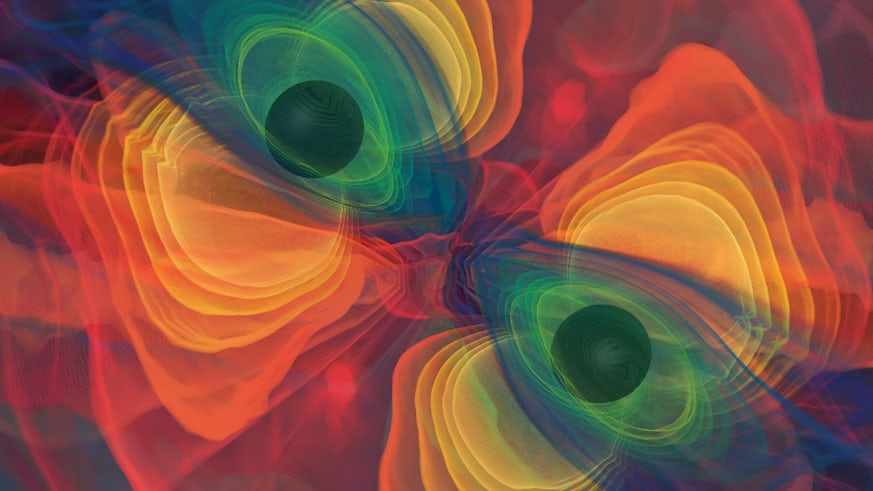Space-time ripples detected for the very first time
11 February 2016

University scientists open a new window into the Universe as gravitational waves are detected for the first time
An international team of scientists, including a group of researchers from Cardiff University’s School of Physics and Astronomy, have directly observed gravitational waves for the very first time, adding the final piece of the jigsaw to Albert Einstein’s general theory of relativity that he proposed exactly 100 years ago.
The detection was made at 9:51am GMT on14 September 2015 by two separate detectors in Louisiana and Washington State, which form part of the Laser Interferometer Gravitational-wave Observatory (LIGO).
The detection completes 50 years’ work of searching for the elusive signals and, thanks to the key contribution of the Gravitational Physics Group at Cardiff University, could now usher in a new era of astronomy that will allow Einstein’s theories to be tested further, and giving researchers a new window to observe extreme cosmic events that are occurring in the Universe.
Professor B S Sathyaprakash, from Cardiff University’s School of Physics and Astronomy, said: “With this phenomenal discovery by LIGO we have opened a new window to observe violent processes in the Universe, such as merging black holes and neutron stars, supernovae, and other cosmic phenomena. We can also use these observations to test Einstein's theory of gravity, and solve riddles of dark matter and dark energy.”
First predicted by Einstein in 1916, gravitational waves are tiny ripples in space-time that are emitted as a result of violent cosmic events, such as exploding stars and merging black holes. Gravitational waves carry information about their dramatic origins and about the nature of gravity that cannot otherwise be obtained.
Like the consequences of a stone dropping in a pond, the tiny ripples travel outwards into space, but they are so small that we have not been able to detect them on Earth – until now.
The LIGO collaboration have announced that the detected gravitational waves were produced during the final fraction of a second of two black holes merging together to form a single, massive black hole around 1.3 billion light years away from Earth. It is estimated that the two black holes were around 29 and 36 times the mass of the Sun.
Research undertaken at Cardiff University has laid the foundations for how we go about detecting gravitational waves with the development of novel algorithms and software that have now become standard search tools for detecting the elusive signals.
The Gravitational Physics Group also includes world-leading experts in the collision of black holes, who have produced large-scale computer simulations to imitate these violent cosmic events and predict how gravitational waves are emitted as a consequence. These calculations were instrumental in decoding the observed gravitational-wave signal to measure the properties of the two black holes.
In addition to this fundamental work, the group contributed significant computing power to the LIGO collaboration, using supercomputers at the University to sift through the large amounts of data produced by the two detectors to find tell-tale signs of a gravitational wave.
“It is absolutely incredible that we have today directly detected black holes, over 40 years ago since I first heard about them in a public talk,” continued Professor Sathyaprakash. “Our students and postdocs over the 20 years have contributed tremendously to this exciting discovery and I am extremely excited to share this news with them.”
Professor Mark Hannam, from Cardiff University’s School of Physics and Astronomy, said: “This observation has confirmed so many things that we guessed, but didn’t know for sure – that black holes exist with many tens of times the mass of the sun, and so do black-hole binaries. This has transformed our understanding of the Universe, but is just the beginning.”
Dr Patrick Sutton, from Cardiff University’s School of Physics and Astronomy, said: “Every time astronomers have learned how to view the universe in a new way, they've found things that were completely unexpected, from Saturn's rings, to pulsars, to microwave echoes of the Big Bang. This first-ever observation of a pair of black holes, as they spiral into each other, will allow us to put Einstein’s theory to the test in the most extreme event since the Big Bang itself.”
Dr Stephen Fairhurst, from Cardiff University’s School of Physics and Astronomy, said: “This is a spectacular confirmation of many of the predictions of Einstein’s general theory of relativity. Furthermore, this discovery heralds the beginning of gravitational wave astronomy, a brand new way to observe the universe.”
Caltech’s David H. Reitze, executive director of the LIGO Laboratory, said: “Our observation of gravitational waves accomplishes an ambitious goal set out over 50 years ago to directly detect this elusive phenomenon and better understand the universe, and fulfills Einstein’s legacy on the 100th anniversary of his general theory of relativity.”
First Minister of Wales, Carwyn Jones AM, said: “Science advances through collaborative effort. Isaac Newton famously said that his discoveries came about because he built on work that had come before him, that he stood on the shoulders of giants. Today we have a discovery that confirms the work of another giant of gravitational physics, Albert Einstein. I’m proud that researchers at a Welsh University have been able to contribute in a fundamental way toward such a huge discovery that will bring us new insights into the workings of our universe. I congratulate the scientists at Cardiff University on their role in this remarkable breakthrough.”
LIGO research is carried out by the LIGO Scientific Collaboration (LSC), a group of around 950 scientists from universities in over 15 countries. The LSC detector network includes the LIGO interferometers in Livingston, Louisiana, and Hanford, Washington. The discovery was made possible thanks to a major upgrade to the detectors, labelled Advanced LIGO (aLIGO), that increased the ultimate sensitivity of the instruments by a factor of 10, enabling a 1,000-fold increase in the volume of the universe within reach of LIGO.
